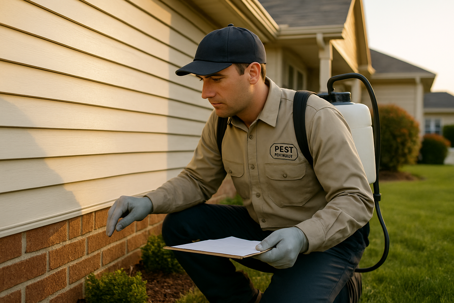End-of-Summer Home Hardening Playbook (Treasure Valley Edition)
Late summer in the Treasure Valley is when warm days and cool nights push pests closer to structures. By the time fall arrives in Nampa, Boise, Meridian, Caldwell, Eagle, and Star, spiders, ants, mice, and wasps may already be scouting attics, garages, crawl spaces, and living areas. Use this playbook now to stop the fall surge before it starts.
Quick Materials Kit
Caulk (paintable exterior), backer rod • Weatherstripping & door sweeps • Steel wool + sealant or ¼-inch hardware cloth • Outlet/switch foam gaskets • Lidded bins for pet/people food • Heavy-duty trash can lids • Flashlight/headlamp • Thick gloves and masks for crawl/attic checks.
1) Seal & Inspect Entry Points (Exclusion First)
Pests exploit tiny openings: mice can pass through ¼-inch gaps; ants and spiders need hairline cracks. Do a slow “walk-around” and a “crawl-under”:
- Common entry points: gaps under garage and exterior doors; utility penetrations (plumbing, cable, gas); foundation and siding cracks; unscreened or torn vents; attic soffits and roof-edge penetrations.
- Fixes that last: install door sweeps; caulk and backer rod at siding transitions; stuff steel wool in small utility gaps and seal; use ¼-inch hardware cloth for larger holes and vents; add outlet/switch foam gaskets to reduce drafts and insect pathways.
- Local cues: Meridian garages that face the street often show door daylight; Nampa/Caldwell utility penetrations to crawl spaces are frequent hot spots; Eagle/Star soffits and gables are common wasp/spider entry points.
Why this matters: exclusion is the foundation of rodent and insect control. It prevents re-entry, cuts pesticide need, and protects against wiring/insulation damage.
2) Sanitation & Clutter Reduction (Remove Food/Harborage)
Clean, organized spaces are far less attractive to pests:
- Indoors: store pet and pantry foods in hard, sealed containers; wipe sugars/grease daily; empty trash/recycling regularly; pull out and clean under appliances.
- Garages/sheds: move cardboard and fabric storage into lidded totes; elevate items off the floor; keep bird seed and pet foods sealed.
- Yards: clear leaf piles and wood from siding; keep lids tight on outdoor cans; rinse recycling.
- Caldwell note: stacked totes and seed/fodder bags along fence lines and sheds are frequent mouse/spider harborage.
3) Outdoor Maintenance & Landscaping (Reduce Bridges & Buffets)
Your exterior sets the pressure at the wall:
- Trim plants so shrubs/trees don’t touch siding or roof edges—this removes ant/spider “bridges.”
- Keep grass tight along fences (vole/mouse cover).
- Clean gutters and ensure downspouts move water away from the foundation; standing water invites insects and raises crawl-space humidity.
- Firewood: store 20+ feet from buildings and off the ground to limit spiders/rodents.
4) Attic & Crawl-Space Checks (The Overlooked Zones)
These spaces often tell the story first:
- Rodents: droppings, rub marks, gnawing, shredded insulation, runs along sill plates.
- Spiders: webbing on trusses, around vents, and in corners (watch for black widow in dark, undisturbed areas).
- Ants/beetles: trails along beams, moisture-damaged wood, or debris accumulations.
- Boise note: older North End crawl spaces commonly show rodent pressure; newer Meridian/Star attics frequently harbor spiders thanks to stable temperatures and plentiful prey.
5) Schedule Preventive Service (Pair DIY with Pro Timing)
DIY steps go far, but pairing them with professional service locks in results:
- Exterior barriers targeted at foundations, thresholds, and eaves reduce spider/ant pressure.
- Residual dusts in select voids (crawl/attic) provide long-term protection against spiders and beetles.
- Rodent programs: trapping indoors for fast reduction; tamper-resistant exterior bait stations to reduce outside pressure; written exclusion list to close re-entry points.
- Follow-ups: brief visits through the early fall let techs re-position baits, verify reduction, and pivot from late-summer wasps/ants to fall/winter rodents as temperatures drop.
Why This Checklist Matters Here
- Nampa & Caldwell: harvest and field transitions push rodents toward neighborhoods.
- Boise & Meridian: dense subdivisions create continuous ant/spider corridors and frequent utility penetrations.
- Eagle & Star: river corridor and foothill edges bring wasps, beetles, and fall “occasional invaders” closer to homes.
No matter your city, late summer is the critical window. Exclusion + sanitation + landscape fixes, paired with a preventive service, stops the fall invasion before it starts.
Sources
- U.S. EPA — Integrated Pest Management (IPM) in Buildings (inspection, sanitation, exclusion as first steps): https://www.epa.gov/safepestcontrol/integrated-pest-management-ipm-principles
- CDC — Rodent Control: Seal Up / Trap Up / Clean Up (¼-inch rule; materials and safe cleanup): https://www.cdc.gov/healthy-pets/rodent-control/seal-up.html; https://www.cdc.gov/healthy-pets/rodent-control/clean-up.html
- Pacific Northwest Pest Management Handbooks — Public Health: Spiders (regional species; medically important context): https://pnwhandbooks.org/insect/structural-health/public-health/public-health-spider
- PNW Insect Management Handbooks — Nuisance & Household Ants (baits, exclusion, moisture management): https://pnwhandbooks.org/insect/structural-health/nuisance-household/nuisance-household-ant
- University of Maryland Extension — Social Wasps: Yellowjackets, Hornets, and Paper Wasps (seasonality and behavior at structures): https://extension.umd.edu/resource/social-wasps-yellowjackets-hornets-and-paper-wasps
- National Park Service — Rodent Exclusion Manual (mechanical proofing: vents, doors, penetrations): https://www.nps.gov/orgs/1103/upload/NPS-Rodent-Exclusion-Manual-Mechanical-Rodent-Proofing-Techniques_2019_508.pdf

